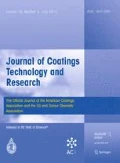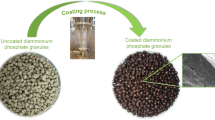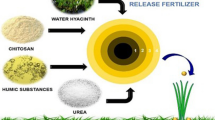Abstract
Slow release fertilizers (SRFs) are of vital importance to improve agricultural efficiency. However, their use is still limited due to their relatively high costs. Additionally, most of coating materials used to produce SRFs are nonbiodegradable and toxic to the soil. In this context, we utilized various biopolymers such as tamarind, xanthan, and guar gums together with diatomite to coat urea fertilizer granules. In this study, tamarind–urea-diatomite (TUD), guar–urea-diatomite (GUD), and xanthan–urea-diatomite (XUD) SRF granules were prepared in the presence of epichlorohydrin as crosslinker. The nutrients slow release behavior and the water retention capacity of these SRFs in soil were determined. The water absorbency of the product was 89% TUD, 93% GUD, and 142% XUD of its own weight when it was allowed to swell in tap water at room temperature for 2 h. Poly(methacrylic acid) was applied as the outermost layer of XUD to improve the nitrogen slow release efficiency of XUD SRFs. The results showed that the product had an excellent nutrients slow release property of 79.5% and good water retention capacity of 62.9% after 28 days. This suggested that XUDM could effectively improve the utilization of fertilizer. Furthermore, being biodegradable and low cost could be beneficial in agricultural and horticultural applications.








Similar content being viewed by others
References
Zhang, Y, Liang, X, Yang, X, Liu, H, Yao, J, “An Eco-Friendly Slow-Release Urea Fertilizer Based on Waste Mulberry Branches for Potential Agriculture and Horticulture Applications.” ACS Sustain. Chem. Eng., 2 1871–1878 (2014)
Wu, L, Liu, M, Rui, L, “Preparation and Properties of a Double-Coated Slow-Release NPK Compound Fertilizer with Superabsorbent and Water-Retention.” Bioresour. Technol. , 99 547–554 (2008)
Heffer, P, Prudhomme, M, “Fertilizer Outlook 2012–2016”. International Fertilizer Industry Association (IFA) Annual Conference. Doha, Qatar, 2012
Gioacchini, P, Nastri, A, Marzadori, C, Giovannini, C, Antisari, LV, Gessa, C, “Influence of Urease and Nitrification Inhibitors on N Losses from Soils Fertilized with Urea.” Biol. Fert. Soils, 36 129–135 (2002)
Zhou, L, Chen, L, Li, R, Wu, Z, “Behavior of Soil Urea N and Its Regulation Through Incorporating with Inhibitors Hydroquinone and Dicyandiamide”. Fertilization in the Third Millenium—Fertilizer, Food Security and Environmental Protection, Proceedings, pp. 1175-1192. Liaoning Science and Technology Publishing House, China (2003).
Azeem, B, KuShaari, K, Man, ZB, Basit, A, Thanh, TH, “Review on Materials & Methods to Produce Controlled Release Coated Urea Fertilizer.” J. Controll. Release, 181 11–21 (2014)
Blouin, GM, “Method of Making Sulfur-Coated Fertilizer Pallet Having a Controlled Dissolution Rate.” Google Patents US 3295950 A, 1967.
Akelah, A, “Novel Utilizations of Conventional Agrochemicals by Controlled Release Formulations.” Mater. Sci. Eng. C, 4 83–98 (1996)
Jarosiewicz, A, Tomaszewska, M, “Controlled-Release NPK Fertilizer Encapsulated by Polymeric Membranes.” J. Agric. Food Chem., 51 413–417 (2003)
Naz, MY, Sulaiman, SA, “Testing of Starch-Based Carbohydrate Polymer Coatings for Enhanced Urea Performance.” J. Coat. Technol. Res., 11 747–756 (2014)
Ni, B, Liu, M, Lü, S, Xie, L, Wang, Y, “Environmentally Friendly Slow-Release Nitrogen Fertilizer.” J. Agric. Food Chem., 59 10169–10175 (2011)
Wu, L, Liu, M, “Preparation and Properties of Chitosan-Coated NPK Compound Fertilizer with Controlled-Release and Water-Retention.” Carbohydr. Polym., 72 240–247 (2008)
Chang, I, Im, J, Prasidhi, AK, Cho, GC, “Effects of Xanthan Gum Biopolymer on Soil Strengthening.” Constr. Build. Mater., 74 65–72 (2015)
Dumitriu, S (ed.) Polysaccharides: Structural Diversity and Functional Versatility, pp. 459–475. Marcel Dekker, New York (2005)
Bueno, VB, Bentini, R, Catalani, LH, Petri, DFS, “Synthesis and Swelling Behavior of Xanthan-Based Hydrogels.” Carbohydr. Polym., 92 1091–1099 (2013)
Feng, E, Ma, G, Wu, Y, Wang, H, Lei, Z, “Preparation and Properties of Organic–Inorganic Composite Superabsorbent Based on Xanthan Gum and Loess.” Carbohydr. Polym., 111 463–468 (2014)
Bergmann, D, Furth, G, Mayer, C, “Binding of Bivalent Cations by Xanthan in Aqueous Solution.” Int. J. Biol. Macromol., 43 245–251 (2008)
Nolte, H, John, S, Smidsrød, O, Stokke, BT, “Gelation of Xanthan with Trivalent Metal Ions.” Carbohydr. Polym., 18 243–251 (1992)
Laneuville, SI, Turgeon, SL, Sanchez, C, Paquin, P, “Gelation of Native β-Lactoglobulin Induced by Electrostatic Attractive Interaction with xanthan Gum.” Langmuir, 22 7351–7357 (2006)
Kumar, CS, Bhattacharya, S, “Tamarind Seed: Properties, Processing and Utilization.” Crit. Rev. Food Sci., 48 1–20 (2008)
Wang, Q, Ellis, PR, Ross-Murphy, SB, Burchard, W, “Solution Characteristics of the Xyloglucan Extracted from Detarium senegalense Gmelin.” Carbohydr. Polym., 33 115–124 (1997)
Freitas, RA, Martin, S, Santos, GL, Valenga, F, Buckeridge, MS, Reicher, F, Sierakowski, MR, “Physico-Chemical Properties of Seed Xyloglucans from Different Sources.” Carbohydr. Polym., 60 507–514 (2005)
Patel, TR, Morris, GA, Ebringerová, A, Vodeničarová, M, Velebný, V, Ortega, A, Garcia de la Torre, J, Harding, SE, “Global Conformation Analysis of Irradiated Xyloglucans.” Carbohydr. Polym., 74 845–851 (2008)
Sims, IM, Gane, AM, Dunstan, D, Allan, GC, Boger, DV, Melton, LD, Bacic, A, “Rheological Properties of Xyloglucans from Different Plant Species.” Carbohydr. Polym., 37 61–69 (1998)
Khounvilay, K, Sittikijyothin, W, “Rheological Behaviour of Tamarind Seed Gum in Aqueous Solutions.” Food Hydrocoll., 26 334–338 (2012)
Sumathi, S, Alok, R, “Release Behavior of Drugs from Tamarind Seed Polysaccharide Tablets.” J. Pharm. Pharm. Sci., 5 12–18 (2002)
Soumya, RS, Vineetha, VP, Reshma, PL, Raghu, KG, “Preparation and Characterization of Selenium Incorporated Guar Gum Nanoparticle and Its Interaction with H9c2 Cells.” PLoS ONE, 8 74411 (2013)
Gupta, AP, Verma, DK, “Preparation and Characterization of Carboxymethyl Guar Gum Nanoparticles.” Int. J. Biol. Macromol., 68 247–250 (2014)
Rea, I, Martucci, NM, De Stefano, L, Ruggiero, I, Terracciano, M, Dardano, P, Migliaccio, N, Arcari, P, Taté, R, Rendina, I, Lamberti, A, “Diatomite Biosilica Nanocarriers for siRNA Transport Inside Cancer Cells.” BBA-Gen. Subj., 1840 3393–3403 (2014)
Şan, O, Gören, R, Özgür, C, “Purification of Diatomite Powder by Acid Leaching for Use in Fabrication of Porous Ceramics.” Int. J. Miner. Process., 93 6–10 (2009)
Goren, R, Baykara, T, Marsoglu, M, “A Study on the Purification of Diatomite in Hydrochloric Acid.” Scand. J. Metall., 31 115–119 (2002)
Goren, R, Baykara, T, Marsoglu, M, “Effects of Purification and Heat Treatment on Pore Structure and Composition of Diatomite.” Brit. Ceram. T, 101 177–180 (2002)
Zohuriaan, MJ, Shokrolahi, F, “Thermal studies on natural and modified gums.” Polym Test, 23 575–579 (2004)
Milani, J, Maleki, G, “Hydrocolloids in Food Industry”. INTECH Open Access Publisher, 2012.
Bakass, M, Mokhlisse, A, Lallemant, M, “Absorption and Desorption of Liquid Water by a Superabsorbent Polymer: Effect of Polymer in the Drying of the Soil and the Quality of Certain Plants.” J. Appl. Polym. Sci., 83 234–243 (2002)
Bhardwaj, A, Shainberg, I, Goldstein, D, Warrington, D, Levy, JG, “Water Retention and Hydraulic Conductivity of Cross-Linked Polyacrylamides in Sandy Soils.” Soil Sci. Soc. Am. J., 71 406–412 (2007)
Ni, B, Liu, M, Lü, S, Xie, L, Zhang, X, Wang, Y, “Novel Slow-Release Multielement Compound Fertilizer with Hydroscopicity and Moisture Preservation.” Ind. Eng. Chem. Res., 49 4546–4552 (2010)
Zheng, Y, Li, P, Zhang, J, Wang, A, “Study on Superabsorbent Composite XVI. Synthesis, Characterization and Swelling Behaviors of Poly (Sodium Acrylate)/Vermiculite Superabsorbent Composites.” Eur. Polym. J., 43 1691–1698 (2007)
Khraisheh, MAM, Al-Ghouti, MA, Allen, SJ, Ahmad, MN, “Effect of OH and Silanol Groups in the Removal of Dyes from Aqueous Solution Using Diatomite.” Water Res., 39 922–932 (2005)
Trenkel, ME, Slow- and Controlled-Release and Stabilized Fertilizers: An Option for Enhancing Nutrient Use Efficiency in Agriculture.. IFA, International Fertilizer Industry Association, Paris (2010)
Navia, DRJ, Betancourt, ARE, Diez, JMC, Sepúlveda, RNZ, Curaqueo, FGA, Cea, LMX, Toro, ACA, González, RA, González, QME, “Controlled-Release Nitrogen Fertilizer Using Biochar as a Renewable Support Matrix.” Google Patents WO2014091279 A1, 2014.
Quijón, MEG, “Development of a Urea-Based Controlled-Release Nitrogen Fertilizer Using Biochar as Support Material.” Doctoral Thesis In Fulfillment of the Requirements for the Doctor Degree in Sciences of Natural Resources at Universidad de La Frontera, Temuco, Chile, pp. 72–74, 2003.
Acknowledgments
This work was supported by the Scientific Research Foundation for the Returned Overseas Chinese Scholars (State Education Ministry, 2010-1174), and China Spark Program (Ministry of Science and Technology, 2013GA740073).
Author information
Authors and Affiliations
Corresponding author
Additional information
Jean Felix Mukerabigwi and Qing Wang contributed equally to the work.
Rights and permissions
About this article
Cite this article
Mukerabigwi, J.F., Wang, Q., Ma, X. et al. Urea fertilizer coated with biodegradable polymers and diatomite for slow release and water retention. J Coat Technol Res 12, 1085–1094 (2015). https://doi.org/10.1007/s11998-015-9703-2
Published:
Issue Date:
DOI: https://doi.org/10.1007/s11998-015-9703-2




